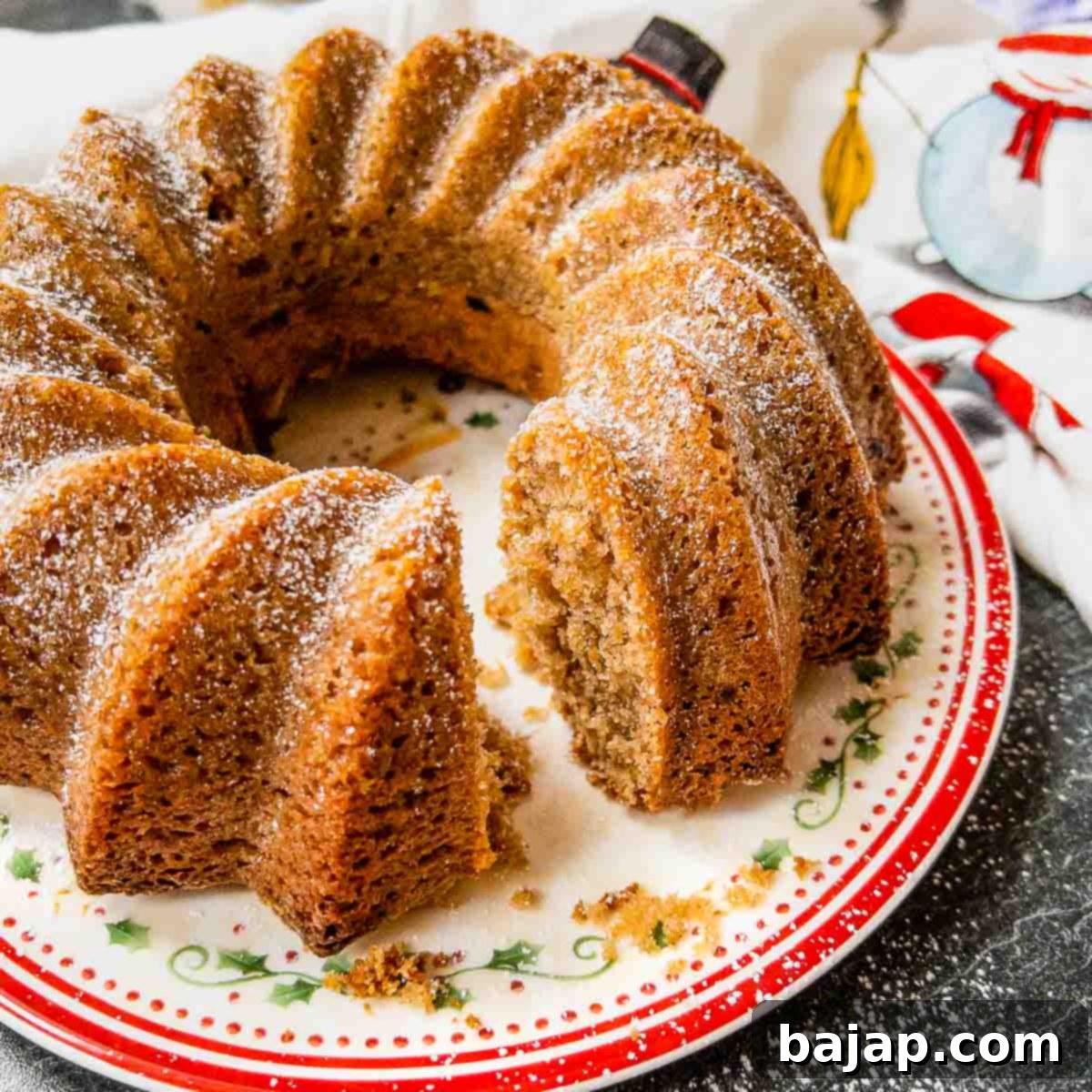Irresistible Chestnut Flour Bundt Cake: Your Guide to a Moist & Flavorful Fall Delight
Prepare to fall in love with this exquisite Chestnut Flour Bundt Cake – a dessert that promises a truly luxurious experience with every bite. Imagine a cake that is beautifully smooth, incredibly moist, and infused with an intense, captivating chestnut aroma. This delightful treat, expertly crafted from a harmonious blend of nutty chestnut flour and classic all-purpose flour, offers a flavor profile that is absolutely unparalleled and deeply satisfying.
Its remarkable texture and rich, deep chestnut flavor make it the quintessential indulgence, whether you’re hosting guests for a special occasion or simply seeking a comforting, elegant snack to enjoy with your afternoon coffee. This cake elevates any gathering, transforming a simple coffee break into a gourmet moment.
Despite its sophisticated taste and appearance, this chestnut Bundt cake is surprisingly simple to prepare. With a straightforward two-step process and a baking time of just 45 minutes, you can whip up this culinary masterpiece in a flash, without any unnecessary fuss or complicated techniques. It’s perfect for both seasoned bakers and those new to the kitchen looking for a rewarding baking project.
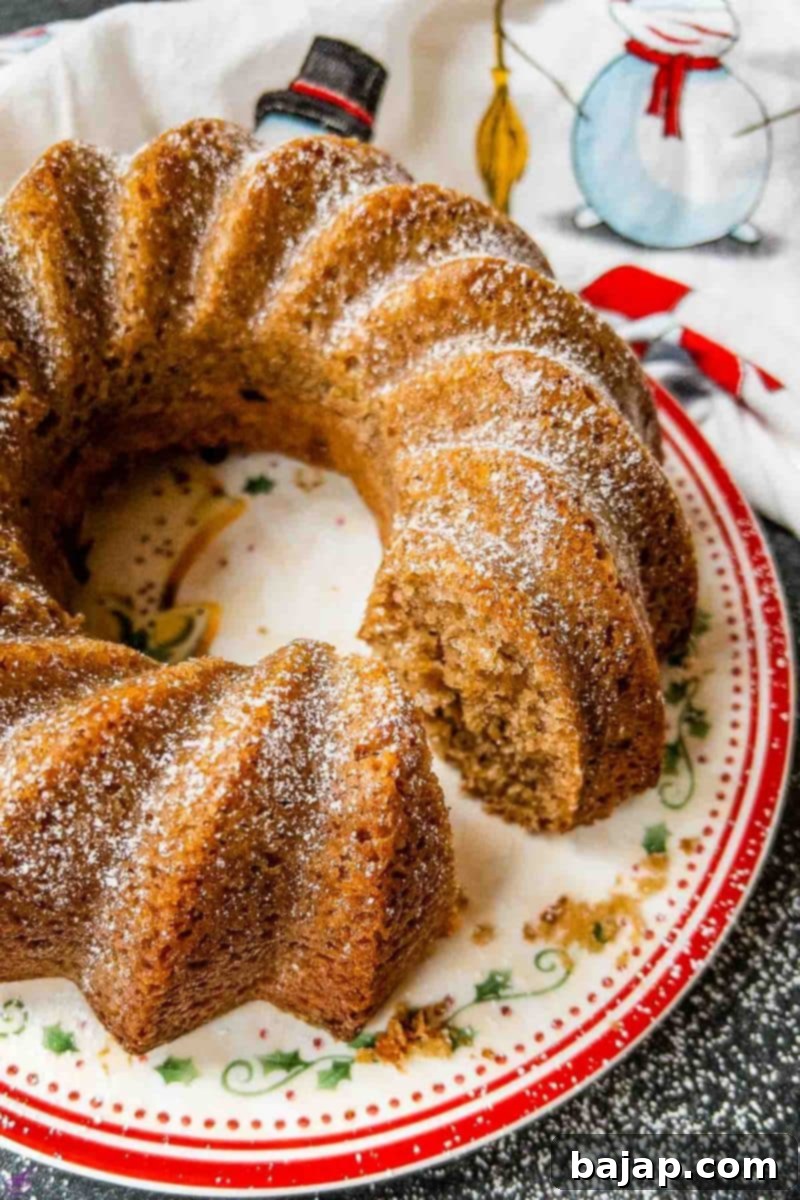
To truly complete this delicious dessert experience, consider pairing a slice of this heavenly chestnut cake with a delightful eggnog coffee for a festive touch, or a rich hot chocolate with rum for an extra layer of warmth and decadence. These beverage pairings perfectly complement the deep, earthy notes of the chestnut, creating a harmonious symphony of flavors.
If you’re as enamored with the unique taste of chestnuts as we are, you’ll be thrilled to explore our other delicious chestnut-infused recipes. Don’t miss our charming waffle blossoms with chestnut purée, a delightful treat for breakfast or dessert, and our incredibly popular chocolate chip cookies with chestnut flour, which offer a chewy texture and a subtle, sophisticated twist on a classic favorite.
🥘 Essential Ingredients for Your Chestnut Bundt Cake
Creating this magnificent chestnut Bundt cake begins with selecting the right ingredients. Each component plays a crucial role in achieving that perfect moist texture and intense flavor that makes this cake so special. Here’s a detailed look at what you’ll need, along with some tips for best results:
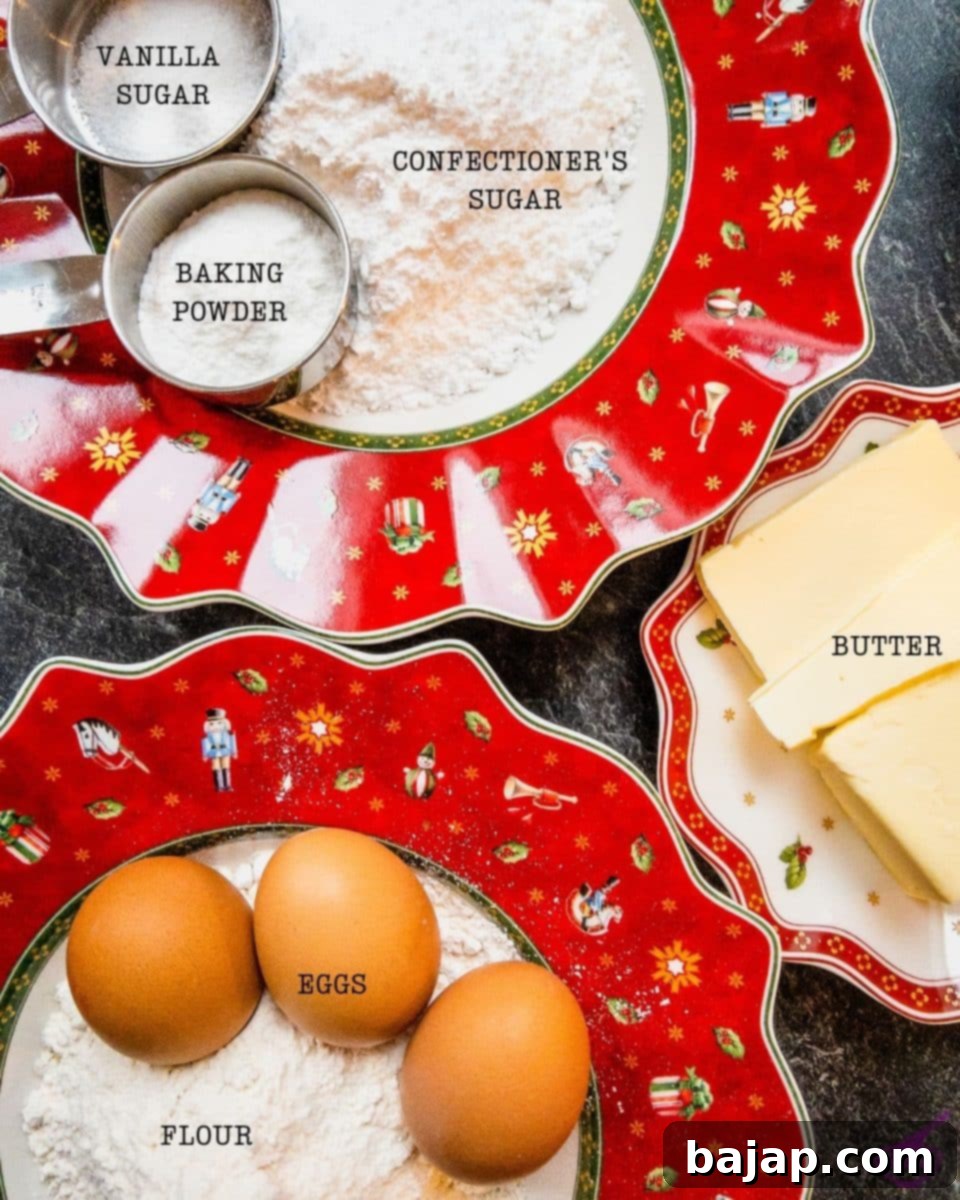
- Unsalted butter: Using unsalted butter gives you complete control over the total salt content in your cake. Ensure your butter is at room temperature to cream easily with the sugar, incorporating air for a light and fluffy batter.
- All-purpose flour: This forms the foundational structure of our cake, providing a tender crumb when balanced with the chestnut flour.
- Chestnut flour: The star ingredient! Finely ground dried chestnuts impart a wonderfully unique, subtly sweet, and earthy flavor, along with a rich, moist texture. It’s also naturally gluten-free and packed with beneficial nutrients (see FAQ section for more on its health benefits!).
- Confectioner’s sugar (powdered sugar): This type of sugar dissolves easily, contributing to the cake’s smooth texture and fine crumb. It adds a gentle sweetness that complements the chestnut flavor without overpowering it.
- Eggs (organic, room temperature): Room temperature eggs emulsify better with the butter and sugar, creating a more cohesive and evenly textured batter. Organic eggs often boast richer yolks and superior flavor, enhancing the overall taste of your cake.
- Baking powder: As the primary leavening agent, baking powder is crucial for ensuring the cake rises beautifully and achieves that desirable airy, yet moist, crumb. It reacts during baking to produce carbon dioxide, giving the cake its lift.
- Vanilla sugar: Whether you use homemade or store-bought, vanilla sugar introduces a warm, aromatic vanilla note that beautifully enhances the natural sweetness and depth of the chestnut.
- Powdered sugar for sprinkling: An optional but highly recommended finishing touch. A dusting of powdered sugar adds a delicate sweetness and an elegant visual appeal to the finished Bundt cake.
- Optional: Chocolate chips: For true chocolate enthusiasts, stirring in a handful of your favorite chocolate chips (dark, milk, or white) can add pockets of melty delight and an extra layer of richness to your chestnut cake.
For precise measurements and detailed quantities, please refer to the comprehensive recipe card provided below.
🔪 Step-by-Step Instructions: Baking Your Perfect Chestnut Bundt Cake
Creating this delightful chestnut Bundt cake is a simple and rewarding process. Follow these easy steps to ensure your cake turns out perfectly moist, flavorful, and beautiful every time.
Step 1: Prepare the Batter
Since the batter comes together quite quickly, begin by preparing your oven. Preheat it to a precise 356 °F (180 °C) using both top and bottom heat settings. This ensures the oven is at the optimal temperature when your cake is ready to go in, promoting even baking and a good rise.
Next, grab a large mixing bowl or the bowl of your trusty food processor (or stand mixer if preferred). Add the room temperature unsalted butter, vanilla sugar, confectioner’s sugar, and eggs. Begin whisking these ingredients together on a medium speed. Continue to mix until the mixture transforms into a light, airy, and fluffy consistency. This creaming process is vital as it incorporates air, which contributes significantly to the cake’s tender crumb.
Once the wet ingredients are perfectly creamed, it’s time to introduce the dry components. Gradually add the all-purpose flour, chestnut flour, and baking powder to the bowl. Mix all the ingredients together with your food processor or mixer on a low speed, just until they are well combined. Be careful not to overmix the batter, as this can develop the gluten in the flour too much, resulting in a tough cake. The finished dough should have a lovely creamy texture – if it appears too dry, you might add a tablespoon or two of milk to reach the ideal consistency.
For those who adore a chocolatey surprise, now is the moment to gently fold in a handful of your favorite chocolate chips into the batter. This optional addition brings a wonderful dimension of flavor and texture.
Step 2: Bake and Cool to Perfection
Before transferring your delicious batter, prepare your Bundt cake pan meticulously. We highly recommend coating the pan thoroughly with baking spray, or alternatively, generously greasing it with butter and then dusting it with a light layer of flour. This crucial step prevents the cake from sticking and ensures you can easily remove the beautifully shaped Bundt cake from the pan once baked and cooled.
Carefully pour the prepared dough evenly into the coated Bundt pan. Gently tap the pan on your counter a few times to release any air bubbles and ensure the batter settles evenly. Place the pan in your preheated oven and bake at 180 °C (356 °F) for approximately 45 minutes. Baking times can vary slightly depending on your oven, so keep an eye on it.
To confirm the cake is perfectly baked, perform the classic toothpick test at the end of the baking time. Insert a clean toothpick into the center of the cake. If it comes out clean with no wet batter clinging to it, your cake is ready! If there’s still wet batter, continue baking for a few more minutes and test again.
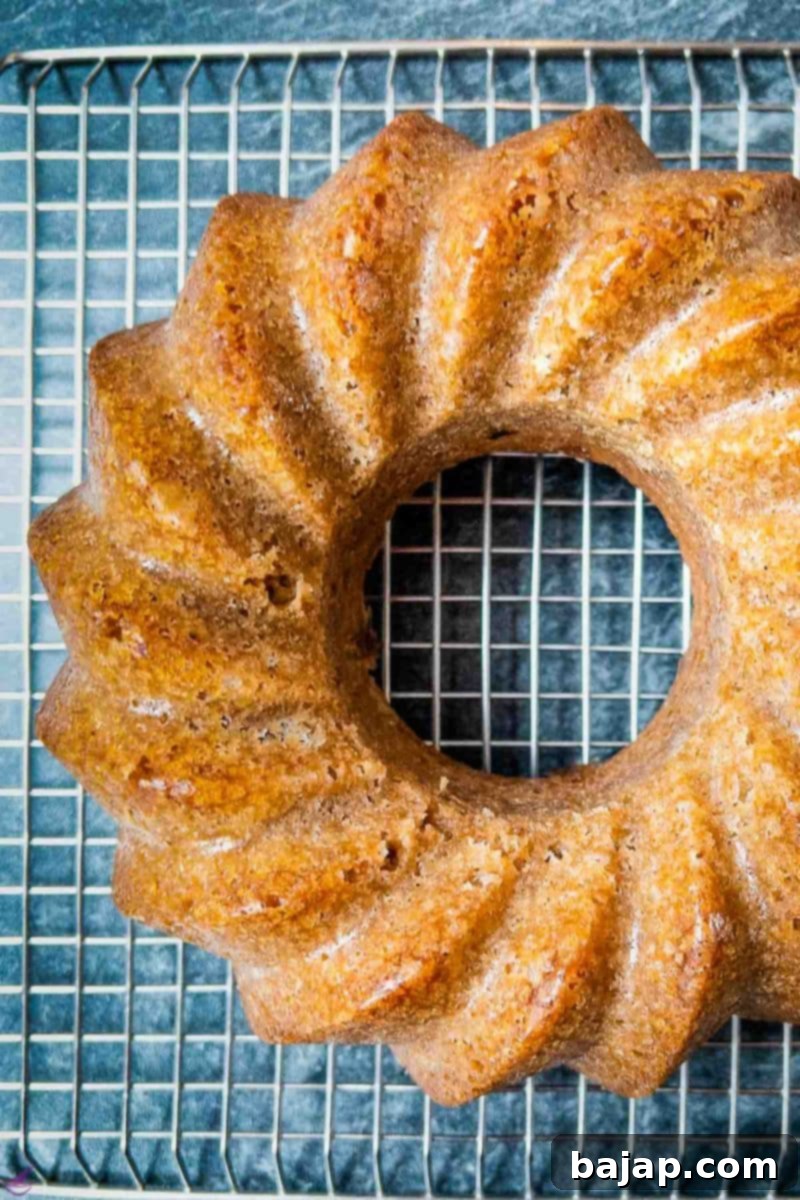
Once baked, remove the Bundt cake from the oven and allow it to cool in the pan on a wire cooling rack for about 10-15 minutes. This allows the cake to firm up slightly before you attempt to invert it. This step is crucial for preventing the cake from breaking apart.
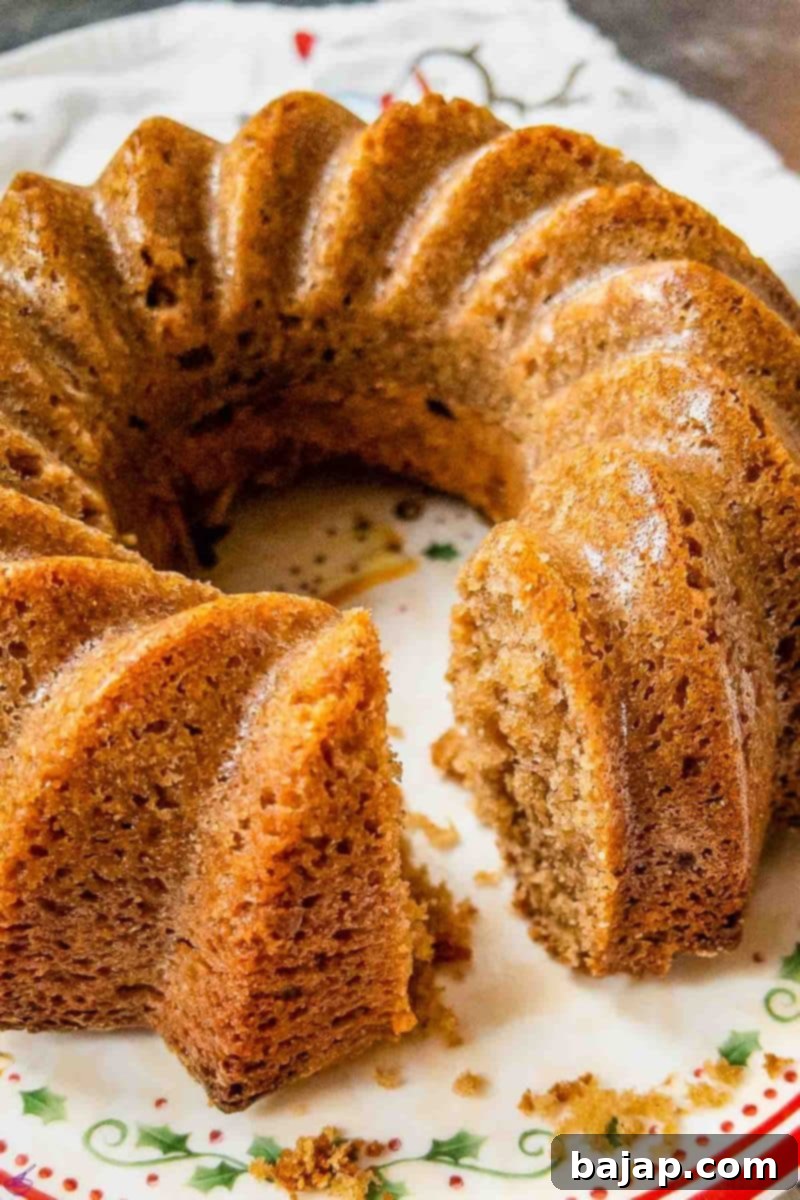
After partial cooling in the pan, carefully invert the Bundt cake onto the cooling rack and let it cool completely. Behold the wonderful texture of this cake when sliced – it’s a testament to the perfect balance of ingredients and baking. Complete cooling prevents condensation and keeps your cake from becoming soggy. This also makes it easier to slice cleanly.
Before serving, dust the cooled Bundt cake generously with powdered sugar. This simple step adds a touch of elegance and a delicate sweetness. If you’re feeling indulgent, serve this delicious dessert with a dollop of freshly whipped cream, a scoop of creamy vanilla ice cream, or even a light drizzle of chocolate sauce. Enjoy the rich, comforting flavors!
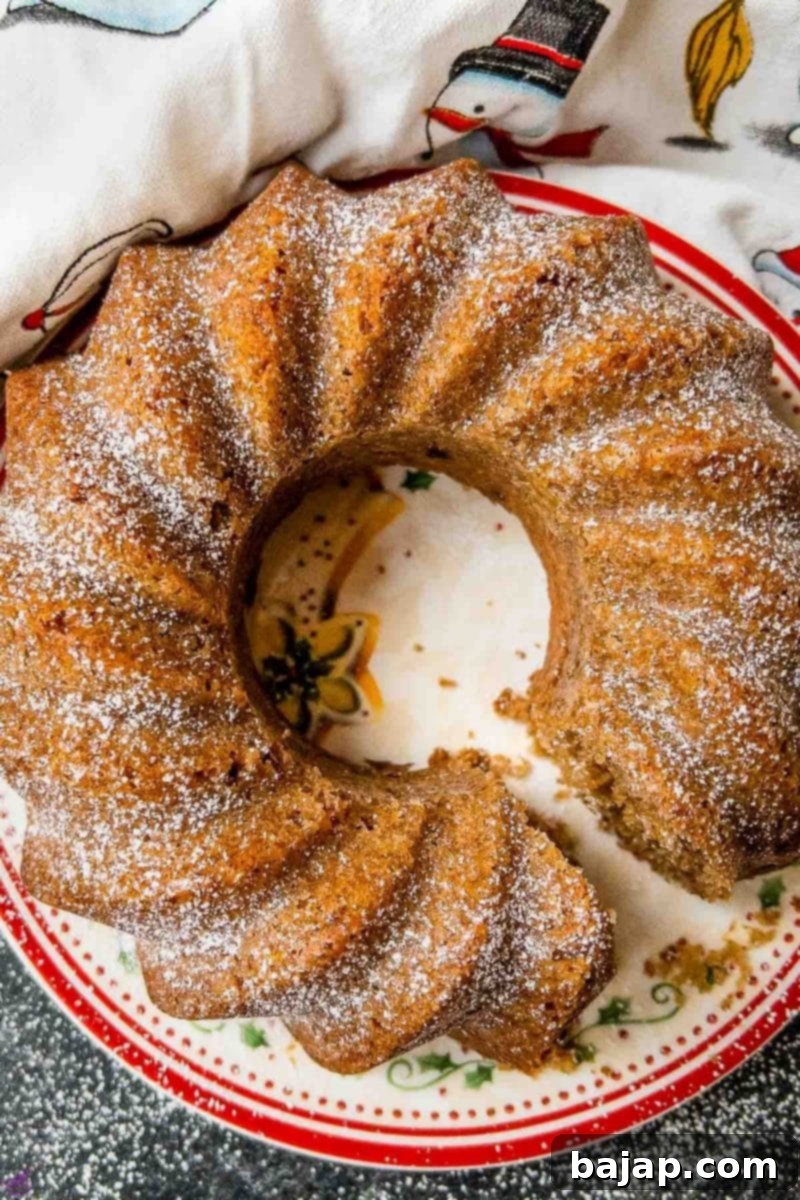
Dust with powdered sugar before serving for a beautiful presentation.
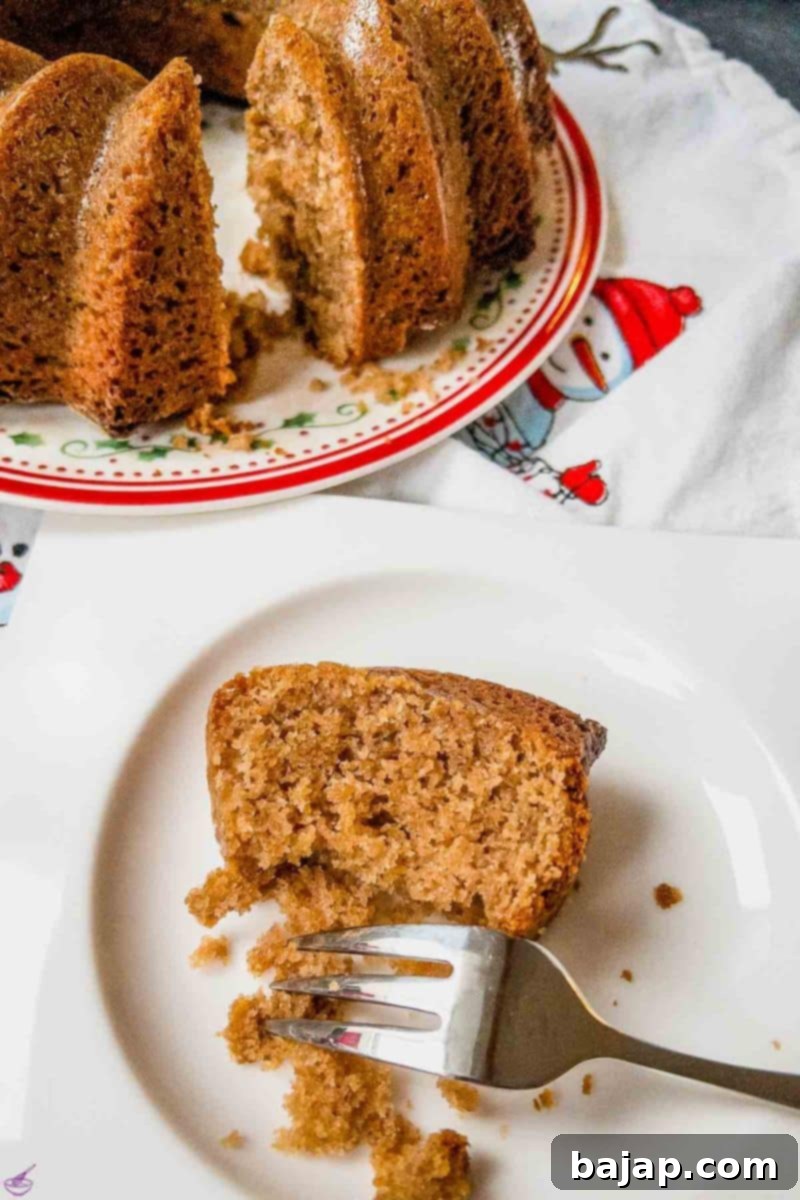
Savor every delicious slice! Enjoy! 🙂
🥜 Smart Substitutions for Your Chestnut Bundt Cake
While this recipe is designed to deliver a specific flavor and texture, sometimes dietary needs or ingredient availability call for creative substitutions. Here are some options to adapt your chestnut Bundt cake:
Making it Gluten-Free
If you’re aiming to make this delicious cake suitable for a gluten-free diet, you’ll need to replace the wheat-based all-purpose flour. Gluten-free baking often requires a blend of different flours to achieve the desired structure and texture. A good rule of thumb is to replace the all-purpose flour with a mixture consisting of two parts gluten-free flour, one part gluten-free starch flour, and one binder.
Here are some examples for each component:
- Gluten-free flours: These provide the bulk and structure. Excellent choices include:
- Buckwheat flour: Offers an earthy, slightly nutty flavor that complements chestnuts well.
- Amaranth flour: Provides a mild, slightly peppery taste and good protein content.
- Millet flour: A light, slightly sweet flour that works well in cakes.
- Quinoa flour: Earthy and slightly bitter, use in moderation or blend with milder flours.
- Almond flour: Adds richness, moisture, and a delicate nutty flavor.
- Soy flour: High in protein, can add a dense texture; use in combination with lighter flours.
- Chickpea flour (Garbanzo bean flour): Has a distinct savory taste, best used in smaller amounts or savory applications, but can work in sweet baking.
- Starch flours: These are essential for lightness and tenderness in gluten-free baking.
- Potato starch: Contributes to a light and fluffy texture.
- Rice flour (white or brown): A versatile gluten-free option, provides a neutral base.
- Corn starch: A common thickener that adds tenderness.
- Tapioca flour (or starch): Adds chewiness and helps with browning.
- Binders: Gluten-free flours lack the elasticity of gluten, so binders are crucial for holding the cake together and preventing a crumbly texture.
- Chia seeds (ground): Form a gel-like consistency when mixed with liquid.
- Flax seeds (ground): Similar to chia seeds, providing binding and fiber.
- Xanthan gum or Guar gum: Common gums used in gluten-free baking to mimic gluten’s elasticity. Use sparingly as too much can make baked goods gummy.
- Tapioca flour: While also a starch, it has binding properties.
- Agar-agar: A plant-based gelatin substitute, can be used as a binder.
- Eggs: Act as excellent natural binders, adding moisture and structure.
Experimentation is key in gluten-free baking, so start with a tried-and-true gluten-free all-purpose flour blend first, then adjust with starches and binders as needed for optimal results.
🍽 Essential Equipment for Your Chestnut Bundt Cake
Having the right tools can make all the difference in the baking process, ensuring both ease and excellent results. Here’s a list of equipment that will help you create your perfect Chestnut Bundt Cake:
- Food processor or stand mixer: While you can mix by hand, a food processor or stand mixer makes the creaming of butter and sugar, and subsequent mixing of dry ingredients, much quicker and more efficient, ensuring a consistent batter.
- Large mixing bowl: Essential for combining all your ingredients without spills.
- Bundt pan: The star equipment for this recipe! Its distinctive fluted design not only creates a beautiful presentation but also allows for more even baking. Choose a good quality non-stick pan for easy release.
- Baking spray or unsalted butter: Crucial for properly greasing your Bundt pan to prevent sticking. A thorough coating ensures your cake releases perfectly.
- Cooling rack: Allows air to circulate around the cake as it cools, preventing the bottom from becoming soggy and ensuring even cooling throughout.
- Toothpicks or cake tester: For checking doneness accurately.
- Measuring cups and spoons: For precise ingredient measurements.
🌡 Storage Tips for Your Chestnut Bundt Cake
Proper storage is key to maintaining the delicious flavor and moist texture of your Chestnut Bundt Cake. Here’s how to keep it fresh for as long as possible:
This delectable Chestnut Bundt Cake will retain its freshness and moistness for a good week when stored correctly. The best method is to keep it under a cake cover or in an airtight cake carrier at room temperature. This protects it from drying out and keeps it soft and delicious, ready for your next coffee break or dessert.
If you wish to extend the cake’s shelf life beyond a week, freezing is an excellent option. Once the cake has cooled completely, we recommend cutting it into individual slices. This allows for convenient portioning later. Place the slices in an airtight freezer-safe container or wrap them individually in plastic wrap and then foil to prevent freezer burn. When you’re ready to enjoy a slice, simply thaw it at room temperature for an hour or two, or gently warm it in the microwave for a few seconds for that freshly baked feel. Frozen, the cake will keep well for up to 2-3 months.
🙋🏻 Frequently Asked Questions About Chestnut Flour Bundt Cake
Here are some common questions about chestnut flour and this delicious cake:
Absolutely! Chestnut flour is not only a fantastic culinary ingredient but also a remarkably healthy alternative to conventional wheat flour and a natural, wholesome sweetener. It stands out due to its impressive nutritional profile. In addition to being a source of starch, chestnut flour is rich in complex carbohydrates, which are digested slowly, providing sustained energy, promoting longer-lasting satiety, and helping to regulate blood sugar levels more effectively than simple sugars. This makes it an excellent choice for maintaining stable energy throughout the day.
Furthermore, it contains many beneficial dietary fibers that are crucial for digestive health, promoting regularity and supporting a healthy gut microbiome. But what else makes chestnut flour so healthy? You’ll also find an exceptionally high content of Vitamin C, a powerful antioxidant that strengthens the immune system and aids in collagen production. It’s also a great source of the essential mineral potassium, vital for maintaining healthy blood pressure, fluid balance, and proper heart function.
An added benefit for many is that chestnut flour is an alkaline-forming food, which some believe contributes to overall wellness. Crucially, it is naturally gluten-free, making it an excellent option for individuals with celiac disease or gluten sensitivity, allowing them to enjoy delicious baked goods without compromise.
Chestnut flour, while perhaps not as ubiquitous as wheat flour, is becoming increasingly accessible. You can often find it in select ethnic markets, especially those specializing in European or Mediterranean ingredients, or in well-stocked health food stores. For the broadest selection and convenience, it is most easily found online through retailers like Amazon or other specialized gourmet food websites. Look for finely ground, high-quality chestnut flour for the best results in baking.
Chestnut flour has a distinctive flavor profile that is subtly sweet, nutty, and earthy. It’s less assertive than some other nut flours, offering a delicate sweetness with a hint of roasted flavor. This makes it incredibly versatile for both sweet and savory applications, blending beautifully with other ingredients without overpowering them. In this Bundt cake, it imparts a deep, comforting autumn flavor that is both unique and familiar.
While you can certainly incorporate fresh chestnuts into baking, they cannot be directly substituted for chestnut flour in terms of volume or weight. Chestnut flour is a dried, finely ground product that acts as a structural component. If you wish to use fresh chestnuts for added texture and flavor, you would need to roast, peel, and then purée them to create a chestnut purée. This purée could then be added to the batter as an additional ingredient (perhaps reducing some of the liquid or butter to maintain consistency), but it wouldn’t replace the flour itself. For this particular Bundt cake, sticking to chestnut flour as specified is recommended for the intended texture.
A Bundt cake is a cake baked in a Bundt pan, which is a ring-shaped mold with fluted or decorative sides. The distinctive shape of the pan often leaves a decorative pattern on the cake itself, making it appealing even without elaborate frosting. The design also allows for more even heat distribution during baking, often resulting in a perfectly cooked and moist cake. While the name “Bundt” is derived from a German word “Bundkuchen” (a type of ring cake), the modern Bundt pan was popularized in North America by Nordic Ware in the 1960s.
More delicious cake recipes for you to try:
- Flourless Chocolate Cake
- Egg White Chocolate Cake
- Austrian Strawberry Sponge Cake
- Potato Flour Cake with Eggnog
- Whipping Cream Bundt Cake
- Chocolate Chip Ricotta Loaf Cake
- Double Chocolate Bundt Cake
If you make this recipe, let me know how you liked it by ★★★★★ star rating it and leaving a comment below. This would be awesome! You can also sign up for our Newsletter or follow me on Pinterest or Instagram and share your creation with me. Just tag me @combinegoodflavors and hashtag #combinegoodflavors, so I don’t miss it.
📖 Recipe Card: Delicious Chestnut Bundt Cake
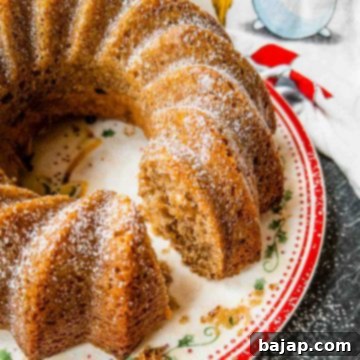
Chestnut Bundt Cake
By Nora
Save RecipeSaved!
Pin Recipe
Equipment
-
Food processor (or stand mixer for ease of mixing)
-
Large mixing bowl
-
Bundt Pan (for its distinctive shape and even baking)
-
Baking spray or unsalted butter (for greasing the pan)
-
Cooling Rack (essential for proper airflow during cooling)
-
Toothpicks or cake tester (for checking doneness)
Ingredients
- 5.64 oz Unsalted butter
- ¾ cup All purpose flour
- ½ cup Chestnut flour
- 1 ¼ cups Confectioner’s sugar
- 3 Eggs (room temperature, preferably organic)
- 1 tablespoon Baking powder
- ¾ tablespoon Vanilla sugar
- Powdered sugar (for dusting before serving)
- Optional: handful of chocolate chips
Instructions
-
Preheat your oven to 356 °F (180 °C) with top and bottom heat. This ensures a consistent temperature for even baking.
-
In a large bowl or the mixing bowl of your food processor (or stand mixer), combine the vanilla sugar, room temperature unsalted butter, confectioner’s sugar, and eggs.1 ¼ cups Confectioner’s sugar, 3 Eggs, ¾ tablespoon Vanilla sugar, 5.64 oz Unsalted butter
-
Whisk the mixture until it becomes light, fluffy, and well combined. Then, add the all-purpose flour, chestnut flour, and baking powder.¾ cup All purpose flour, ½ cup Chestnut flour, 1 tablespoon Baking powder
-
Mix all ingredients with the food processor (or mixer) on low speed until just combined. Be careful not to overmix. If desired, gently fold in a handful of chocolate chips. The finished dough should be creamy and not too dry.
-
Generously coat your Bundt pan with baking spray or butter to prevent sticking.
-
Pour the prepared batter evenly into the greased Bundt pan and bake at 180 °C (356 °F) for 45 minutes, or until a toothpick inserted into the center comes out clean.
-
Once baked, let the Bundt cake cool in the pan on a cooling rack for 10-15 minutes before inverting it onto the rack to cool completely.
-
Store the cooled cake under a cake cover to maintain its moisture. Just before serving, sprinkle generously with powdered sugar for a beautiful finish.Powdered sugar
Nutrition values are estimates only, using online calculators. Please verify using your own data.

🌰 You might also like these chestnut-inspired creations!
If you’ve enjoyed the unique flavor of chestnut flour in this Bundt cake, you’re in for a treat with these other delightful recipes featuring chestnuts. Explore more ways to incorporate this wonderful ingredient into your cooking and baking:
- Chocolate Chip Cookies with Chestnut FlourA chewy, soft, and nutty twist on a classic, these cookies are a must-try for any chocolate and chestnut lover!
- Waffle Blossoms with Chestnut PuréeDelicate waffle blossoms generously filled with a velvety homemade chestnut purée – an elegant and irresistible dessert.
- Chestnut and Porcini Mushroom Soup {Dutch Oven}A hearty and flavorful soup combining the earthy goodness of chestnuts and porcini mushrooms, perfect for a cozy meal.
- Brussels Sprouts with Chestnuts and Bacon {20 minutes}A quick and delicious side dish featuring tender Brussels sprouts, crispy bacon, and sweet, roasted chestnuts, ready in just 20 minutes.
⛑️ Important Food Safety Guidelines
Ensuring food safety is paramount when preparing any meal. Following these guidelines will help keep your kitchen and your delicious creations safe:
- Temperature matters: Always cook food to its minimum recommended internal temperature of 165 °F (74 °C) to eliminate harmful bacteria. While this applies less directly to baking, ensuring proper oven calibration prevents undercooked batter.
- Prevent cross-contamination: Never use the same utensils or cutting boards on cooked food that have previously touched raw meat, poultry, or eggs without thorough washing.
- Hand hygiene: Always wash your hands thoroughly with soap and warm water after handling raw ingredients, especially meat and eggs.
- Time limits: Do not leave perishable food sitting out at room temperature for extended periods. Bacteria can multiply rapidly between 40 °F (4 °C) and 140 °F (60 °C).
- Stay attentive: Never leave cooking food unattended on the stove or in the oven. This helps prevent burns, fires, and overcooking.
- Cooking oils: Use cooking oils with high smoking points (like canola, vegetable, or grapeseed oil) when frying or sautéing at high temperatures to avoid producing harmful compounds.
- Ventilation: Always ensure good ventilation in your kitchen when using a gas stove or oven to prevent the buildup of carbon monoxide and other fumes.
For more comprehensive information and detailed advice on safe food handling practices, please refer to authoritative sources such as the Safe Food Handling – FDA guidelines.
